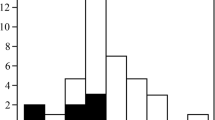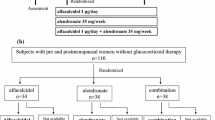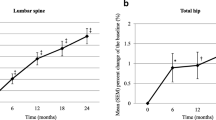Abstract
Our objective was to investigate the efficacy of intravenous alendronate for the treatment of glucocorticoid-induced osteoporosis (GIOP) in children with autoimmune diseases. Five children with autoimmune disease and GIOP were treated with 5 mg intravenous alendronate once every 3 months. After 1 and 2 years, we evaluated the changes in the Z score of the femoral neck bone mineral density (BMD), serum bone alkaline phosphatase, and urinary deoxypyridinoline. Six patients with GIOP, whose BMD could be observed over a 1-year period without alendronate treatment, were defined as controls. After 1 and 2 years of treatment, intravenous treatment significantly inhibited bone loss. The efficacy of alendronate demonstrated a significant correlation with a high level of bone turnover markers before alendronate treatment. Intravenous alendronate is considered to be a good choice for the treatment of GIOP because of its excellent efficacy. In addition, our study suggests that the efficacy of alendronate depends on the bone turnover of patients before treatment. Intervention with bisphosphonates during periods of high bone turnover may be recommended.


Similar content being viewed by others
References
Cetin A, Celiker R, Dincer F et al (1998) Bone mineral density in children with juvenile chronic arthritis. Clin Rheumatol 17:551–553
Falcini F, Trapani S, Civinini R et al (1996) The primary role of steroids on the osteoporosis in juvenile rheumatoid patients evaluated by dual energy X-ray absorptiometry. J Endocrinol Invest 19:165–169
Trapani S, Civinini R, Ermini M et al (1998) Osteoporosis in juvenile systemic lupus erythematosus: a longitudinal study on the effect of steroids on bone mineral density. Rheumatol Int 18:45–49
Siomou E, Challa A, Tzoufi M et al (2003) Biochemical markers of bone metabolism in infants and children under intravenous corticosteroid therapy. Calcif Tissue Int 73:319–325
Rabinovich CE (2004) Osteoporosis: a pediatric perspective. Arthritis Rheum 50:1023–1025
American College of Rheumatology Ad Hoc Committee on Glucocorticoid-Induced Osteoporosis (2001) Recommendations for the prevention and treatment of glucocorticoid-induced osteoporosis: 2001 update. American College of Rheumatology Ad Hoc Committee on Glucocorticoid-Induced Osteoporosis. Arthritis Rheum 44:1496–1503
Bone and Tooth Society of Great Britain, National Osteoporosis Society, Royal College of Physicians (2002) Glucocorticoid-induced osteoporosis: a concise guide to prevention and treatment. Available at http://www.rcplondon.ac.uk/pubs/books/glucocorticoid/
Nawata H, Soen S, Takayanagi R et al (2005) Guidelines on the management and treatment of glucocorticoid-induced osteoporosis of the Japanese Society for Bone and Mineral Research (2004). J Bone Miner Metab 23:105–109
Rodan GA, Fleisch HA (1996) Bisphosphonates: mechanisms of action. J Clin Invest 97:2692–2696
Bianchi ML, Cimaz R, Bardare M et al (2000) Efficacy and safety of alendronate for the treatment of osteoporosis in diffuse connective tissue diseases in children: a prospective multicenter study. Arthritis Rheum 43:1960–1966
Noguera A, Ros JB, Pavia C et al (2003) Bisphosphonates, a new treatment for glucocorticoid-induced osteoporosis in children. J Pediatr Endocrinol Metab 16:529–536
Papaioannou A, Ioannidis G, Adachi JD et al (2003) Adherence to bisphosphonates and hormone replacement therapy in a tertiary care setting of patients in the CANDOO database. Osteoporos Int 14:808–813
Segal E, Tamir A, Ish-Shalom S (2003) Compliance of osteoporotic patients with different treatment regimens. Isr Med Assoc J 5:859–862
Passeri M, Baroni MC, Pedrazzoni M et al (1991) Intermittent treatment with intravenous 4-amino-1-hydroxybutylidene-1,1-bisphosphonate (AHBuBP) in the therapy of postmenopausal osteoporosis. Bone Miner 15:237–247
Thiebaud D, Burckhardt P, Kriegbaum H et al (1997) Three monthly intravenous injections of ibandronate in the treatment of postmenopausal osteoporosis. Am J Med 103:298–307
Thiebaud D, Burckhardt P, Melchior J et al (1994) Two years’ effectiveness of intravenous pamidronate (APD) versus oral fluoride for osteoporosis occurring in the postmenopause. Osteoporos Int 4:76–83
Takahashi Y, Minamitani K, Kobayashi Y et al (1996) Spinal and femoral bone mass accumulation during normal adolescence: comparison with female patients with sexual precocity and with hypogonadism. J Clin Endocrinol Metab 81:1248–1253
DiMeglio LA, Ford L, McClintock C et al (2004) Intravenous pamidronate treatment of children under 36 months of age with osteogenesis imperfecta. Bone 35:1038–1045
Simon JA, Lewiecki EM, Smith ME et al (2002) Patient preference for once-weekly alendronate 70 mg versus once-daily alendronate 10 mg: a multicenter, randomized, open-label, crossover study. Clin Ther 24:1871–1886
Emkey R, Koltun W, Beusterien K et al (2005) Patient preference for once-monthly ibandronate versus once-weekly alendronate in a randomized, open-label, cross-over trial: the Boniva Alendronate Trial in Osteoporosis (BALTO). Curr Med Res Opin 21:1895–1903
Srivastava T, Alon US (2003) The role of bisphosphonates in diseases of childhood. Eur J Pediatr 162:735–751
Brumsen C, Hamdy NA, Papapoulos SE (1997) Long-term effects of bisphosphonates on the growing skeleton. Studies of young patients with severe osteoporosis. Medicine (Baltimore) 76:266–283
van Persijn van Meerten EL, Kroon HM, Papapoulos SE (1992) Epi- and metaphyseal changes in children caused by administration of bisphosphonates. Radiology 184:249–254
Illidge TM, Hussey M, Godden CW (1996) Malignant hypercalcaemia in pregnancy and antenatal administration of intravenous pamidronate. Clin Oncol (R Coll Radiol) 8:257–258
Munns CF, Rauch F, Ward L et al (2004) Maternal and fetal outcome after long-term pamidronate treatment before conception: a report of two cases. J Bone Miner Res 19:1742–1745
Acknowledgment
We thank Dr. Brian Quinn and Ms. Margaret Dooley Ohto for reviewing the manuscript.
Conflicts of interest statement
None.
Author information
Authors and Affiliations
Corresponding author
Rights and permissions
About this article
Cite this article
Inoue, Y., Shimojo, N., Suzuki, S. et al. Efficacy of intravenous alendronate for the treatment of glucocorticoid-induced osteoporosis in children with autoimmune diseases. Clin Rheumatol 27, 909–912 (2008). https://doi.org/10.1007/s10067-008-0864-6
Received:
Revised:
Accepted:
Published:
Issue Date:
DOI: https://doi.org/10.1007/s10067-008-0864-6




